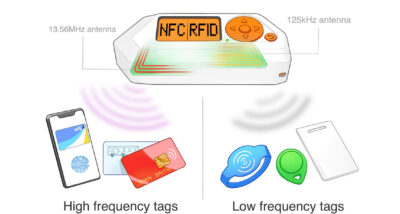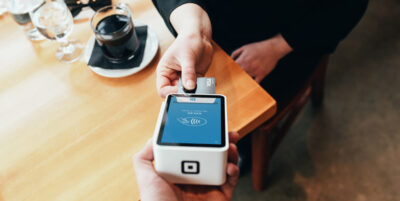What is the future of RFID and NFC SmartCard ?
Analysts have been predicting an explosion of RFID adoption for the past decade; the market, however, has grown slowly and steadily. A Research and Markets report, though, forecasts global sourcing of RFID tags to have a compound annual growth rate of 11% through 2025.
Along with wider adoption, new technologies will help make RFID more reliable and cost-effective for a larger number of applications.
Innovative Manufacturing Will Create Durable and Versatile Tags
Advancements in printed electronics have helped create new classes of extremely thin, flexible RFID tags that can now be combined with printed sensors, printed batteries, thin-film photovoltaic solar cells, and other technologies. With new electronic printing and conductive ink technologies, companies could conceivably print their own chipless RFID tags on site.
There are also companies working on 3D printing technology that would enable direct printing of electronics in products as they are rendered. While the printing of RFID tags directly inside products may be several years away, the technology is rapidly evolving to do so.
New Antenna Designs Could Increase Range
The key to good tag performance is the antenna design. It’s the antenna that helps determine where and how a tag can be used, and how well it will perform. Over the next few years, expect to see new antennas and inlays as the competition for RFID antenna design heats up.
RFID tag antennas are important for getting RF signals around refractive and absorbent materials. Metals and liquids are the RFID kryptonite. Thus for some applications, an antenna above the tracked object is sufficient to get around metal or liquid.
Increased Memory Will Create Smart Tags
Building intelligence into the tag and, by extension, the asset being tagged is another key activity. Expect tags with more memory at a lower cost to enable these “smart asset” applications. High-value assets will be an early application for this technology, as the cost of those assets will make it easier to amortize the increased cost of the more robust tags
This could be very promising for security applications where it might make sense for inventory to track its own attributes rather than distributing that information across a computer network. Defense and intelligence contractors especially stand to benefit from this technology.
Use Sensor Integration to Streamline Your Business
RFID will increasingly be one part of a whole ecosystem of sensors and communication technologies that will help companies better monitor and manage assets and shipments. Passive sensors for temperature, moisture, pressure, vibration and other factors will be combined with RFID to provide even more intelligence from the edge of the enterprise.
With advanced IoT applications, it may be possible to integrate RFID sensors into your industrial control systems. This can allow you to automate and streamline tasks that used to require a mediating technology or intervening employee.
Secure Your Data With New Cloud-Based Capabilities
RFID can potentially enable a whole host of new applications in the retail, healthcare, manufacturing and other sectors, but one stumbling block has always been management of the data flowing in from thousands of tags. With cloud-based applications and services taking the heavy lifting of IT support away from the point of activity, companies can now deploy centrally managed and centrally available solutions without the traditional support and deployment costs.
Cloud-based applications enable coordination from anywhere. Get real time updates on inventory across global supply chains, making just-in-time production possible across borders.
Flexible Printing Options
RFID tags can be printed at your facilities depending on the material you need the RFID tags to be made from. Printing can be done with industrial printers, desktop devices, and even mobile devices.
Additionally, printing materials can be tailored for specific uses such as high temperature environments and repeated stress. RFID media can also vary between durable hard tags and flexible inlays
Technological Integrations
RFID technology allows you to integrate inventory and asset management into other business technologies. Enable real time work-in-process tracking, instant inventory audits, and reduced search times with any of a variety of RFID solutions.
In addition to mobile scanners, there are a number of fixed RFID tracking solutions that can monitor throughput in a variety of applications. Track items across assembly lines, through a distribution center, or around a warehouse.
Environmental Responsibility
In addition to the sustainability benefits of alleviating bottlenecks and gluts, RFID tags themselves are becoming available with environmentally sustainable options for materials and usage. The EU has established waste management standards that affect the use of RFID tags, particularly those intended to be single use. As manufacturers of RFID products come into compliance with these standards, RFID technology will be more environmentally friendly.
Final Thoughts and Takeaways
The RFID industry is about to enter an exciting period in which increased adoption will provide the means for technology providers to invest in new, exciting innovations. Along with the new developments described above, advancements in materials, organic polymers, nanotechnology, and other areas will change the way RFID is incorporated into products. Instead of a tag attached to a garment, for example, an RFID transponder could be printed directly into cloth or packaging using biodegradable conductive inks.
The future of RFID is here, so both end users and RFID manufacturers should be prepared to leverage these new technologies and ready themselves for more widespread use of RFID. To get started with RFID technology or to learn more, contact Lowry Solutions today to schedule a consultation.

What is next to RFID?
NFC is best described as a subset of RFID. NFC devices operate at the same frequency as high frequency RFID readers and tags — 13.56 MHz. But unlike RFID devices and tags, NFC does not have a range from 25 meters to 100 meters. Instead, NFC takes advantage of the short read range limitations of its radio frequency.
The advantages of using smart cards for security access control systems include enhanced security, improved convenience, and greater flexibility. The disadvantages include the potential for unauthorized access, difficulty in tracking usage, and the potential for data breaches.
What is the future enhancement of smart card?
Using smart card can lower transaction cost, handling cost, and costs associated with banking system infrastructure supports. The card will bring much conveniences to the consumers by combing the functions of multiple cards into one and given the ability to make transactions on/off line and peer-to-peer.
echnology is exploding faster than the average person can keep up with it. From new cloud services to smartphones, you are inundated with evolving technology on a daily basis.
Two of those technologies that you might have heard about fall into the category of wireless communication. Radio frequency identification (RFID) and near-field communication (NFC) are advancing quickly in today’s tech-focused environment. RFID and NFC are used across the globe in untold numbers in applications such as access control, asset tracking and contactless payments.
If you have the latest in smartphone technology, you probably have an NFC-enabled device that allows you to charge wirelessly and tap your phone to a screen for contactless payments at the gas station, grocery store or other location. And your four-footed friend quite possibly has an RFID microchip implanted under its skin, so in case it gets lost, shelters and veterinarians can get your pet returned to you quickly.
But in terms of your business, what is ideal for network security in your small business or enterprise company?
NFC is best described as a subset of RFID. NFC devices operate at the same frequency as high frequency RFID readers and tags — 13.56 MHz. But unlike RFID devices and tags, NFC does not have a range from 25 meters to 100 meters. Instead, NFC takes advantage of the short read range limitations of its radio frequency. Because NFC devices must be in close proximity to each other, no more than a few centimeters apart, NFC has become the top choice for secure communication between consumer devices such as smartphones.
NFC enables peer-to-peer communication between devices because it acts as both a reader and a tag. NFC smartphones can share information just by tapping the devices together. Want to share a photo or your contact info? No need to text or break out a business card, simply bump your phones together. Want to pay for a purchase without digging out your wallet? No problem, tap your smartphone to a contactless payment port at the business of your choosing.
In business terms, NFC is ideal for businesses wanting to communicate and share information quickly between employees. NFC tags can boost staff communication and provide real-time updates in the fast-paced business world. NFC tags allow employees to check in at their current locations, record time spent on the clock and provide updated schedules.
For small businesses focused on customers, payments and wait times, NFC card readers might be the ideal solution. It creates faster and more efficient ways to get through the checkout line.
No matter whether you run a small business or a large corporation, there is a wireless communication technology that can assist you. For businesses that need assistance with time management, employee tracking, customer satisfaction and reduced wait times, NFC is probably the technology for you. For businesses that need assistance with inventory tracking and access management, RFID is most likely the way to go. Consider the needs of your organization, including the security features and range capabilities, before making a decision — both technologies offer a new and improved way of completing tasks.

We are focused on delivering a world-class customer experience while growing brands, loyalty and software enabled services.
We innovate now while we look ahead toward tomorrow. We take responsibility and win with integrity. We are one team.
We are creating a leading health and safety culture while striving for a diverse, equitable and inclusive team.

